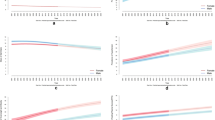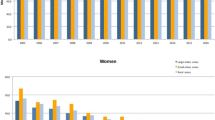Abstract
Diverse modifiable factors seem to be involved in the etiology of different non-communicable diseases (NCDs), such as cancer, diabetes, and cardiovascular diseases. These pathologies are complex in nature, and their prevalence, incidence, and mortality rates are strongly related to social, cultural, and socioeconomic determinants. The occurrence of NCDs is closely related to four main modifiable risk factors: tobacco use, physical inactivity, the harmful use of alcohol, and an unhealthy diet, all of them characteristic of current societies and their lifestyle in this century. Besides, certain authors propose a structural approach where poverty and differences in income have been indicated as the main drivers of premature deaths from chronic diseases. Specifically, it has been reported that, in Argentina, geographic differences in terms of urban scale and socioeconomic conditions could explain the inequities in the prevalent NCD mortality burden, which in effect, are distributed unequally between social groups and geographic regions. In this chapter, an analysis of the geographical distribution of the prevalence of some of the main chronic diseases and their risk factors linked to lifestyles in Argentina is proposed. The prevalence of arterial hypertension, diabetes, and obesity by sex and, in addition, specific risk factors (smoking, excessive alcohol consumption, and sedentary lifestyle) were used for the construction of maps. Data were obtained from the first, second, and third National Survey of Risk Factors carried out during the years 2005, 2009, and 2013 by the National Health Ministry. These indicators were used to construct prevalence maps for each of the years studied and by sex at the provincial scale. Various socioeconomic indicators were also overlapping through symbols proportional to their magnitude. The main indicator used was the socioeconomic level index. Additionally, the percentage of households with at least one unsatisfied basic necessity (as an indicator of structural poverty) and of the population without complete primary studies were also represented. The study of the territorial differences in the prevalence of several of the main NCDs in Argentina and their most recognized conditioning factors contributes to the knowledge of local realities when contemplating the contextual socioeconomic scenarios of each of these spaces. This is essential and could be used as grounds when designing specific strategies to address individual and structural health threats in our population.
Access this chapter
Tax calculation will be finalised at checkout
Purchases are for personal use only
Similar content being viewed by others
References
Allen L, Williams J, Townsend N, Mikkelsen B, Roberts N, Foster C, Wickramasinghe K (2017) Socioeconomic status and non-communicable disease behavioral risk factors in low-income and lower-middle-income countries: a systematic review. Lancet Glob Health 5(3):e277–e289
American Diabetes Association (ADA) (2019) Classification and Diagnosis of diabetes mellitus, 2019. Diabetes Care 42(1):513–528
Barreto SM, Miranda JJ, Figueroa JP, Schmidt MI, Munoz S, Kuri-Morales PP, Silva JB Jr (2012) Epidemiology in Latin America and the Caribbean: current situation and challenges. Int J Epidemiol 41(2):557–571
Brunotto M, Zárate AM, Bono A, Barra JL, Berra S (2014) Risk genes in head and neck cancer: a systematic review and meta-analysis of last 5 years. Oral Oncol 50(3):178–188
Clark J (2014) Medicalization of global health 3: the medicalization of the non-communicable diseases agenda. Glob Health Action 7:24002
Coronado GD, Beasley J, Livaudais J (2011) Alcohol consumption and the risk of breast cancer. Salud Pública Mex 53(5):440–447
Díaz M, García F, Caro P, Díaz MP (2009) Modelos Mixtos Generalizados para el Estudio de los Determinantes Socioeconómicos del cáncer en Córdoba. Argentina. Estadística Int Stat Educ Institute 16(2):135–146
Diez Roux AV (2015) Health in cities: is a systems approach needed? Cad Saude Publica, vol. 31. Suppl 1:9–13
Finucane, M.M., Stevens, G.A., Cowan, M.J., Danaei, G., Lin, J.K., Paciorek, C.J., Singh, G.M., Gutiérrez, H.R., Lu, Y., Bahalim, A.N., Farzadfar, F., Riley, L.M., Ezzati, M.; Global Burden of Metabolic Risk Factors of Chronic Diseases Collaborating Group (Body Mass Index) (2011) National, regional, and global trends in body-mass index since 1980: systematic analysis of health examination surveys and epidemiological studies with 960 country-years and 9·1 million participants. Lancet 377(9765):557–567
Ford ND, Patel SA, Narayan KM (2017) Obesity in low- and middle-income countries: burden, drivers, and emerging challenges. Annu Rev Public Health 38:145–164
França Tarragó O, Crestanello F, Müller A, Silveri A, Pons JE (2017) El problema del sobrepeso y la obesidad en la niñez y adolescencia. Una mirada desde la Bioética. Anales de la Facultad de Medicina 4(1):14–71
Giovannucci E, Michaud D (2007) The role of obesity and related metabolic disturbances in cancers of the colon, prostate, and pancreas. Gastroenterology 132:2208–2225
Glasgow S, Schrecker T (2015) The double burden of neoliberalism? Non-communicable disease policies and the global political economy of risk. Health Place 34:279–286
Gordois AL, Toth PP, Quek RGW, Proudfoot EM, Paoli CJ, Gandra SR (2016) Productivity losses associated with cardiovascular disease: a systematic review. Expert Rev Pharmacoecon Outcomes Res 16(6):759–769
Guthold R, Stevens GA, Riley LM, Bull FC (2018) Worldwide trends in insufficient physical activity from 2001 to 2016: a pooled analysis of 358 population-based surveys with 1·9 million participants. Lancet Glob Health 18:30357–30367
Instituto Nacional de Estadísticas y Censos (INDEC, Argentina) (2019a) Data bases. https://www.indec.gob.ar/indec/web/Institucional-Indec-BasesDeDatos-2
Instituto Nacional de Estadísticas y Censos (INDEC, Argentina) (2019b) Necesidades básicas insatisfechas [on line]. [Accessed: 09/09/19]. https://sitioanterior.indec.gob.ar/nivel4_default.asp?id_tema_1=4&id_tema_2=27&id_tema_3=66
Jakobsen M, Kolodziejczyk C, Fredslund E, Poulsen P, Msc DL, Johnsen S (2016) Costs of major intracranial, gastrointestinal and other bleeding events in patients with atrial fibrillation—a nationwide cohort study. BMC Health Serv Res 19(4):413–418
López R, Paulina C, Torres G, Cristina M, Salinas AAC, Nájera Medina O (2017) Mecanismos inmunológicos involucrados en la obesidad. Invest Clin 58(2):175–196
Lourenço S, Oliveira A, Lopes C (2012) The effect of current and lifetime alcohol consumption on overall and central obesity. Eur J Clin Nutr 66:813–818
Lyons CL, Kennedy EB, Roche HM (2016) Metabolic Inflammation Differential Modulation by Dietary Constituents. Nutrients 8(5):E247
Naciones Unidas (United Nations) (2015) Asamblea general: Informe del Grupo de Trabajo Abierto sobre los Objetivos de Desarrollo Sostenible. https://www.un.org/ga/search/view_doc.asp?symbol=A/68/970/Add.2&Lang=S
Mendonça RD de, Lopes ACS, Pimenta AM, Gea A, Martinez-Gonzalez MA, Bes-Rastrollo M (2017) Ultra-processed food consumption and the incidence of hypertension in a Mediterranean cohort: the SEGUIMIENTO, Universidad de Navarra project. Am J Hypertens 30(4):358–366
Ministerio de Salud y Desarrollo Social Secretaría de Gobierno de Salud (Argentina) (2019) RESOL-2019–83-APN-SGS#MSYDS. https://www.boletinoficial.gob.ar/detalleAviso/primera/200396/20190121
Ministerio de Salud de la Nación (Argentina) (2019) Hipertensión Arterial. Disponible en http://www.msal.gob.ar/ent/index.php/informacion-para-ciudadanos/hipertension-arterial
Ministerio de Salud de la Nación (Argentina) (2005) Primer Encuesta Nacional de Factores de Riesgo [on line]. [Accessed: 14/05/2019]. http://www.msal.gob.ar/images/stories/bes/graficos/0000000553cnt-2014-10_encuesta-nacional-factores-riesgo-2005_informe-breve-final.pdf
Ministerio de Salud de la Nación (Argentina) (2011) Segunda Encuesta Nacional de Factores de Riesgo [en línea]. [Accessed: 14/05/2019]. http://www.msal.gob.ar/images/stories/bes/graficos/0000000570cnt-2014-10_encuesta-nacional-factores-riesgo-2011_informe-final.pdf
Ministerio de Salud de la Nación (Argentina) (2015) Tercer Encuesta Nacional de Factores de Riesgo [on line]. [Accessed; 14/05/2019]. http://www.msal.gob.ar/images/stories/bes/graficos/0000000544cnt-3ra-encuesta-nacional-factores-riesgo_2013_informe-completo.pdf
Ministerio de Salud de la Nación (Argentina) (2013) Programa Nacional de Lucha contra el Sedentarismo [on line]. [Accessed; 14/11/2019]. http://www.msal.gob.ar/ent/index.php/programas/programa-de-lucha-contra-el-sedentarismo
Ministerio de Salud y Desarrollo Social de la Nación (Argentina), (2019) 4ta Encuesta Nacional de Factores de Riesgo. Informe definitivo. Buenos Aires: Dirección Nacional de Promoción de la Salud y Control de Enfermedades Crónicas No Transmisibles, 262 p
NCD Countdown 2030 collaborators (2018) NCD Countdown 2030: worldwide trends in non-communicable disease mortality and progress towards. Sustain Dev Goal Target 3.4. Lancet 392(10152):1072–1088
Niclis C, Díaz MP, Eynard AR, Román MD, La Vecchia C (2012) Dietary habits and prostate cancer prevention: a review of Observational studies by focusing on South America. Nutr Cancer 64:23–33
Organización mundial de la salud (OMS) (2013) Global action plan for the prevention and control of noncommunicable diseases 2013–2020 [on line]. Geneva: World Health Organization. [Accessed: 10/11/2019]. https://www.who.int/nmh/events/ncd_action_plan/en/
Organización Mundial de la Salud (OMS; World Health Organization, WHO) (2016) Informe Mundial sobre la diabetes. [on line]. WHO. [Accessed: 5/8/2019]. https://www.who.int/diabetes/global-report/es/
Organización Mundial de la Salud (OMS; World Health Organization, WHO) (2017) Enfermedades cardiovasculares. https://www.who.int/es/news-room/fact-sheets/detail/cardiovascular-diseases-(cvds)
Organización Mundial de la Salud (OMS; World Health Organization, WHO) (2019a) Enfermedades no transmisibles. http://www.who.int/mediacentre/factsheets/fs355/es/
Organización Mundial de la Salud (OMS; World Health Organization, WHO) (2019b) Obesidad y sobrepeso. https://www.who.int/es/news-room/fact-sheets/detail/obesity-and-overweight
Organización Mundial de la Salud (OMS; World Health Organization, WHO) (2019c) Alcohol. https://www.who.int/topics/alcohol_drinking/es/
Organización Panamericana de la Salud and Organización Mundial de la Salud (OPS/OMS) (2014) Perfil de enfermedades cardiovasculares. Sistema de información regional de mortalidad 2014. [on line].[Accessed: 15/10/2019]. www.paho.org/hq/dmdocuments/2014/ARGENTINA-PERFIL-ECV-2014.pdf
Organización Panamericana de la Salud and Organización Mundial de la Salud (OPS/OMS), Ministerio de Salud de la Nación (2018a) Indicadores básicos de salud de Argentina. https://www.paho.org/arg/index.php?option=com_content&view=article&id=160:datos-estadisticas&Itemid=304
Organización Panamericana de la Salud and Organización Mundial de la Salud (OPS/OMS) (2018b) Enfermedades No Transmisibles: Perfiles de países, 2018. https://www.who.int/nmh/countries/es/
Organización Panamericana de la Salud (2016) Informe sobre Control del Tabaco en la Región de las Américas: a 10 años del Convenio Marco de la Organización Mundial de la Salud para el Control del Tabaco. Washington, D.C.: OPS; 2016 [on line línea]. [Accessed: 15/10/2019]. http://bit.ly/1OCedu7
Pou SA, Tumas N, Becaria Coquet J, Niclis C, Román MD, Díaz MP (2017a) Burden of cancer mortality and differences attributable to demographic aging and risk factors in Argentina, 1986–2011. Cad Saude Publica 33(2)
Pou SA, Tumas N, Sánchez Soria D, Ortiz P, Díaz MP (2017b) Large-scale societal factors and noncommunicable diseases: Urbanization, poverty and mortality spatial patterns in Argentina. Appl Geogr 86:32–40
Pou SA, Díaz MP, Velázquez GA (2018) Socio-environmental patterns associated with cancer mortality: a study based on a quality of life approach. Asian Pac J Cancer Prev 19(11):3045–3052
Román MD, Niclis C, Tumas N, Díaz MP, Osella AR, Muñoz SE (2014) Tobacco smoking patterns and differential food effects on prostate and breast cancers among smokers and nonsmokers in Córdoba. Argentina. Eur J Cancer Prev 23(4):310–318
Rubinstein A, Colantonio L, Bardach A, Caporale J, García Martí S, Kopitowski K, Alcaraz A, Gibbons L, Augustovski F, Pichón-Rivière A (2010) Estimación de la carga de las enfermedades cardiovasculares atribuible a factores de riesgo modificables en Argentina. Rev Panam Salud Publica 27(4):237–245
Serra Majem L, Ribas Barba L, Aranceta Bartrina J, Pérez Rodrigo C, Saavedra Santana P, Peña Quintana L (2003) Obesidad infantil y juvenil en España. Resultados del estudio enKid (1998–2000). Med Clin (Barc) 121(19):725–732
Velázquez G (2016) A new index for study quality of life: combining socioeconomic and environmental indicators. In: Tonon G (ed) Indicators of Quality of Life in Latin America. Springer International Research, London, pp 57–77
World Health Organization (WHO) (2011) Global status report on noncommunicable diseases 2010. WHO Press, World Health Organization, Ginebra, Suiza, p 176
World Health Organization (WHO) (2013) Global action plan for the prevention and control of noncommunicable diseases 2013–2020. [on line]. [Accessed: 9/09/19]. http://apps.who.int/iris/bitstream/10665/94384/1/9789241506236_eng.pdf
World Health Organization (WHO) (2014) Global Status Report on noncommunicable diseases, 2014 Geneva: WHO; 2014. [on line]. [Accessed: 9/09/19]. http://goo.gl/217Sa7
World Health Organization (WHO) (2018) Global status report on alcohol and health—2018. World Health Organization, Ginebra, Suiza, p 450
Yang JS, Mamudu HM, John R (2018) Incorporating a structural approach to reducing the burden of non-communicable diseases. Global Health 14(1):66
Author information
Authors and Affiliations
Corresponding author
Editor information
Editors and Affiliations
Rights and permissions
Copyright information
© 2022 The Author(s), under exclusive license to Springer Nature Switzerland AG
About this chapter
Cite this chapter
Niclis, C., Aballay, L.R., Becaria Coquet, J. (2022). Socio-Spatial Differences in the Prevalence of Lifestyles Risk Factors Related to Chronic Diseases in Argentina from 2005 to 2013. In: Celemin, J.P., Velázquez, G. (eds) Inequities and Quality of Life in Argentina. The Latin American Studies Book Series. Springer, Cham. https://doi.org/10.1007/978-3-030-94411-7_7
Download citation
DOI: https://doi.org/10.1007/978-3-030-94411-7_7
Published:
Publisher Name: Springer, Cham
Print ISBN: 978-3-030-94410-0
Online ISBN: 978-3-030-94411-7
eBook Packages: Social SciencesSocial Sciences (R0)




